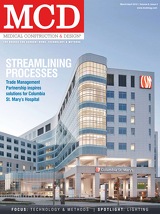Medical Construction & Design (MCD) is the industry's leading source for news and information and reaches all disciplines involved in the healthcare construction and design process. To view more past issues go to: http://mcdmag.epubxpress.com
Page 59 of 70
TECHNOLOGY & METHODS
to send and receive data per a multitude of viewing devices. EMR is more than an electronic fi ling system. It
requires thorough analysis of the existing information workfl ows, options, protocols and virtual collabora- tion. However, plans that are slow, arduous or error- prone must be addressed before touch tablets are handed out to thousands of medical staff. An EMR charter must be created to defi ne its
goals and project scope. Processes and workfl ows broken beyond repair may need to be redesigned fi rst to eliminate waste, redundancy and variation. From a physical facility point of view, developing the charter is a team effort that requires involvement from an interdisciplinary team of healthcare architects, engineers, key medical personnel, IT department folks, and metrics analysts, all of whom should have a return on investment in mind.
IMPACT ON ARCHITECTURAL DESIGN
Healthcare architects experienced in the requirements that eMedicine imposes on a facility, and that ideally have an understanding of Lean Six Sigma (stabilizing and controlling workfl ows and processes) methodology, should be involved in the development of the charter to determine its impact on facility design. The architect should not only participate in
the evaluation of infrastructure and physical space needs, but should also envision the far- reaching changes that will transform the hospital environment. The evaluation of the hospital's infrastructure generally falls into four categories: power management, HVAC systems, communications network infrastructure and human interface. The evaluation of the hospital's ability to implement change often comes down to a question of space, both initial and potential in consideration, of the future unknowns.
MORE POWER
Physical space need is already a common concern in most healthcare facilities. Because of the additional plug loads created by computers, work stations and data servers, additional mechanical equipment and physical space may be required. And the 24x7 opera- tion of devices requires an uninterruptable power supply. In addition, emergency generation equipment and battery backup systems will likely take more
www.mcdmag.com March/April 2012 | Medical Construction & Design 55
space than used to require. Increased space needed for additional equipment or utility closets can be creatively redesigned. HVAC needs will increase too. An increase of
computer use, as well as larger data server rooms, will contribute to greater cooling loads. Architects involved in the design of renovated hospital spaces should engage a mechanical engineer early in the process. How new electronic solutions can be applied
to a typically non-electronic practice to automate processes, save on space and even impact walking distances, currently remains in a somewhat gray area. The design impact on the future facility should consider possible answers to the following questions: Can some staff be more productive working from
